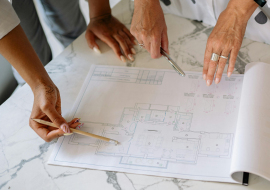4% tax on the acquisition of a primary residence
4% VAT on the acquisition of a primary residence: what does it entail and when is a reduction possible?

A 4% VAT rate is applicable for specific types of real estate transactions involving the purchase of a first home. The following are the conditions, both subjective and objective, that need to be fulfilled.
When can you qualify for the 4% VAT rate when acquiring your first home and what prerequisites are necessary to avail of this benefit? These inquiries are frequently raised by individuals considering the acquisition of a property for their primary dwelling, especially if the transaction is finalized with an entity subject to VAT, like a construction firm.
Typically, when purchasing a property from a VAT-registered company (as opposed to directly from an individual), you are required to pay Value Added Tax (VAT), usually ranging from 10% to 22% of the property's value. Nonetheless, under certain circumstances – such as purchasing a non-luxury property and moving into a new residence – you can benefit from a reduced VAT rate of 4%. This is in addition to other advantages already accessible for first-time home buyers, like a reduction in registration fees. These perks can be utilized multiple times, provided specific conditions are met.
What is covered by the 4% VAT on a first home purchase?
As previously mentioned, the acquisition of a first home is not always executed between private individuals. Frequently, real estate is procured from a VAT-liable company, for instance, when purchasing a new home directly from a developer. In such instances, the buyer is obligated to pay VAT along with the customary registration, cadastral, and mortgage expenses, which can typically amount to 10% to 22% of the property's value.
As elucidated in the guide on first home acquisitions published by the Tax Agency (Agenzia delle Entrate), it is feasible, under certain circumstances, to benefit from the first home incentive, entailing a reduced VAT rate of 4%. This provision was originally introduced by the Finance Act of 1991 and was incorporated into the Unified Text on VAT. It has been reiterated on several occasions and remains in effect to this day. The reduced rate also applies to the extension of existing constructions or the finalization of new developments. However, what criteria must be satisfied to avail of this incentive?
Personal prerequisites for obtaining the 4% VAT on a first home
To be eligible for the 4% VAT, several personal criteria pertaining to the purchaser must be met. Specifically, it is imperative to:
- be an individual, as the benefit does not extend to legal entities such as corporations;
- be a resident in the municipality where the property is situated or have registered your residency there within 18 months from the purchase date;
- not possess another property currently utilized as a primary residence;
- not own or hold rights to other properties previously utilized as primary residences benefiting from the Tax Service. Nonetheless, exceptions exist, for example, if the initial home is sold within 12 months of the new property purchase contract's conclusion, or if the existing property is unsuitable for habitation.
Additionally, it is noteworthy that individuals under 36 years of age meeting the statutory requirements may be entitled to a tax credit equivalent to the VAT rate paid on the property acquisition.
Objective prerequisites for obtaining the 4% VAT on a first home
In conjunction with personal requirements, there are also objective conditions for securing a 4% VAT rate on a first home purchase. In this context, these conditions pertain to the property's characteristics that must be satisfied for the benefit to be valid. Among these conditions are:
- the category of real estate must be recorded in the cadastre as residential premises;
- the property's sole purpose must be residential, not commercial, thereby excluding properties designated for office, retail, warehouse, etc., use;
- Property attributes: it should not be upscale (villas, castles), i.e., it should not fall under categories A/1, A/8, and A/9.
Naturally, the property should be located in Italy and adhere to national and local regulations concerning habitability, safety, and usability.
Real estate categories eligible for the 4% VAT
For clarity, following the enumeration of real estate types ineligible for benefits, we will outline the permissible residential categories eligible for the 4% VAT rate:
- A/2: standard residential premises meeting market requirements for residential structures;
- A/3: affordable housing with basic amenities;
- A/4: Traditional housing constructed using outdated standards;
- A/5: very basic housing with minimal amenities and sanitary facilities;
- A/6: rural homes intended for agricultural purposes;
- A/7: small villas with private outdoor areas;
- A/11: Residential structures typical of specific regions.
When is the 4% VAT applicable in construction?
It is essential to note that the 4% VAT benefits extend not only to real estate acquisitions but also to new construction or the extension of existing properties. In the construction sector, you can consequently benefit from:
- 4% VAT on renovation activities, like purchasing materials for renovating your first home;
- 4% VAT on the construction of a new primary residence if it satisfies cadastral requirements and does not fall under categories A/1, A/8, and A/9;
- 4% VAT on the procurement of essential components for renovating a first home, such as external windows, elevators, and similar elements.
How to reclaim the 4% VAT on your primary residence?
To avail yourself of the 4% VAT benefits for your first home, besides verifying the aforementioned criteria, you must compile the requisite documentation. The application of the reduced VAT rate is not automatic and necessitates a formal request. To do so, you must furnish:
- a copy of the purchaser's identification and tax code;
- a completed form to receive a preferential 4% VAT rate on new constructions and transfer it to the executing company;
- a copy of the building permit or, in the case of new constructions or renovations, the relevant commencement of work notification (SCIA or DIA).
Additionally, it is advisable to include a copy of the notarized deed, a payment receipt for the property purchase or renovation work, and a declaration confirming compliance with the personal and objective requirements. The compiled documents should be submitted to the real estate agents or companies involved in the transaction or construction work.
Advantages of the 4% VAT
The primary benefit of availing the 4% VAT is the potential for substantial savings when acquiring your first home.







